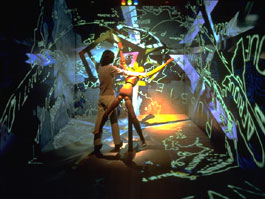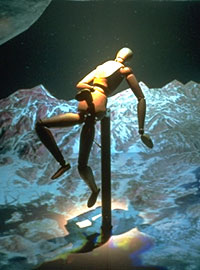|
|
|
||||||
|
|
|||||||
|
The title of this art installation <<conFIGURING the CAVE>> carries two meanings. First, it indicates that the artists have sought to fully articulate the uniquely immersive visualization qualities of the CAVE. Second, it points to the thematic content of this artwork, which identifies the elemental conjunction of "body" and "space," and uses the human figure as the interactive focus for its multiform spatial representations. |
 |
|
|
In this work there are seven different pictorial "worlds" -- each offers a distinct set of conceptual and aesthetic characteristics to the exhibition visitors, and together they constitute a coherent exploration of the manifold relationships between "body", "space," and "language." The computer images are generated by a unique set of algorithms and software tools ("xfrog" by Bernd LINTERMANN) that are able to create an emergent complexity of changing forms. Organic abstraction is conjoined with representational and symbolic forms so that highly original and expressive three-dimensional pictorial spaces are evoked within the CAVE. |
||
|
The interface is based on the stereotypical artist's wooden puppet (mannequin). A large 150 cm tall version has been made with a finely engineered metal skeleton and electronic measurement devices fitted inside all its joints. Fixed onto a column in the center of the CAVE, the visitors can manipulate all the body parts of this puppet, and in so doing send control data to the visualization computer. In this way transformations of the imagery are interactively determined by the way in which people handle the puppet. Moving the puppet's joints effects changing parameters in the image generating software, and certain key postures of the puppet cause specific visual events (for instance, putting the hands over the eyes triggers the transition from one of the seven "worlds" to the next, while rotating the puppet also rotates the visual space). |
 |
|
|
The size and nature of the jointed puppet interface allows up to four people to simultaneously and cooperatively interact with the imagery in the CAVE. Thus, the actual experience of interactivity with this work can be shared by a larger number of visitors. |
||
|
An eight channel spatialised sound system is used for this installation so that the immersive three-dimensional qualities of the visual space can be conjoined with an acoustic environment that augments those qualities. Seven sound compositions have been created for the seven distinct pictorial spaces. These sound compositions are (like the imagery) interactively affected by the visitors' handling of the puppet's body, and thus contribute to a synchronous unity of real time audio-visual transformations. |
||
|
|
||
|
An art installation for the ICC CAVETM in Tokyo by:
Agnes HEGEDU, Jeffrey SHAW, and Bernd LINTERMANN
Music: Leslie STUCK
Motion analysis for music: Jonathan BACHRACH
Production support: ZKM Center for Art and Media Karlsruhe, Fraunhofer Institute IAO, BOCTOK, and David D'HEILLY |
||
|
|
||
|
The CAVE (CAVE Automatic Virtual Environment) system is a general virtual reality system developed by Illinois University's of EVL (Electronic Visualization Laboratory) and NCSA (National Center for Supercomputing Applications) in the United States. 3D images are displayed on four large screens--one that the visitor faces, two on either side, and one on the floor-- generating a virtual image within the space of the CAVE system. By operating a wand, the visitor can examine this generated image from various angles. These interactive 3D images were created by CAVE software produced by the Silicon Graphics Cray Company's graphic system, Onyx Infinite Reality. The superior graphics control functions of Onyx Infinite Reality enable it to render high quality, real-time images in response to the user's input, making for an experience of total immersion in the virtual reality of the CAVE system. |
||